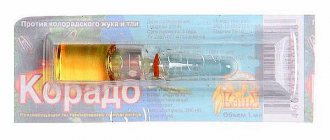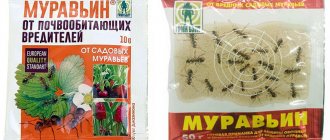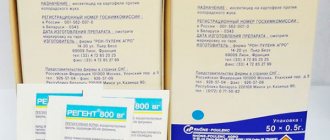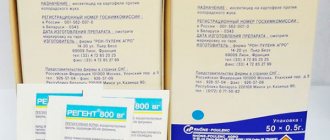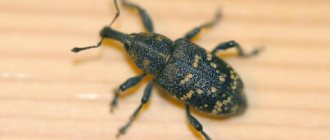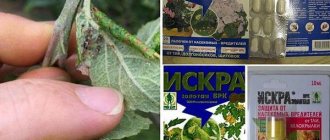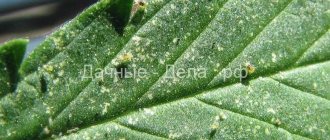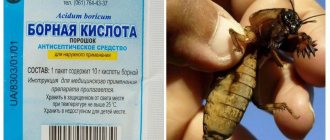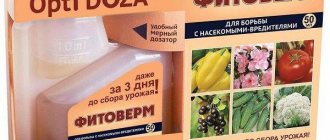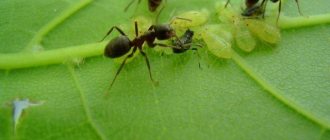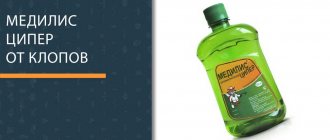The organophosphorus compound (OP) diazinon is developed by Nippon Soda Co. Ltd. (Nippon Kayaku Co. Ltd.) to combat a wide range of harmful arthropods (insects, mites) cohabiting with humans and animals. Distinctive features of the drug that determine its popularity:
- Low price (approx. 1500 rub./l for 2022), which, combined with low consumption rates, determines the low cost of treatment.
- Equally easily penetrates pest organisms both intestinal and contact.
- High efficiency - to completely destroy a harmful population, one, or at least two treatments is enough.
- Long shelf life (up to 4 years in original, unopened packaging).
- Almost complete absence of cumulation (accumulation) in the body of warm-blooded animals.
- Sufficiently rapid hydrolysis to non-toxic products in the body of vertebrates.
- To date, mutagenicity, embryogenicity and teratogenicity of diazinon, as well as long-term post-effects from poisoning with it, have not been observed, i.e. irreparable harm from the drug is possible only as a result of severe acute poisoning.
At the same time, when working with diazinon, you must strictly observe precautions and regulations for use, because:
- Does not have ovicidal activity, i.e. does not destroy eggs, because they lack a nervous system;
- The drug is actually equally highly toxic to warm-blooded animals and arthropods;
- Diazinon easily penetrates the body through the integument and upon reabsorption of fat;
- In a neutral environment, diazinon is difficult to hydrolyze and photolyze: 60 days after use, 15-20% of the active substance remains. Traces of DV are detected after 18 months. after processing;
- In livestock, poultry products and juicy fruits, diazinon residues are detected within 6-9 months. by application;
- The drug easily penetrates into plants through the roots and spreads throughout all plant tissues (has a high systemic effect);
- In juicy fruits, roots and tubers, residues of the drug are detected for up to six months after treatment.
Application area
Diazinon was developed as a veterinary drug for professional use, but due to its high effectiveness, it is also used to prevent entomosis (infestation by fleas and ticks) in pets. In large-scale agricultural technology, diazinon, due to its high translaminar activity, is used for the protection of crops. grains from especially dangerous pests (see below), but the treatment of fruits and vegetables in the garden and vegetable garden with it is excluded - the crop will turn out to be unsuitable for food!
Seasonality
The first period of high parasite activity occurs in early spring. The life cycles of many ticks and flea species intensify the problem beginning in the month of May. Although some parasites have earlier periods of awakening.
This also applies to flea breeding activity. Despite the fact that they have the opportunity to spend the winter in comfortable conditions on stray animals, rodents and in cluttered rooms, they also obey the general annual cycle.
The second peak of activity occurs in mid-summer, approximately from the second half of July. This is due to maximum air heating, dryness and an abundance of dust. During this period, there is an increase in the body temperature of both cats and dogs by several degrees. This additionally creates comfortable conditions for the reproduction of parasites.
The third peak of activity occurs at the end of September. Some ticks are preparing for winter suspended animation and begin to actively feed, collecting a supply of nutrients. You should pay attention to this and apply both types of protection according to the instructions.
Composition and action
Diazinon contains one DV (formula in the figure). Its mechanism of action is a nerve poison (neurotoxin) that phosphorylates animal esterase enzymes. One of the esterases, cholinesterase, is “responsible” for the hydrolysis of acetylcholine, which ensures the transmission of nerve impulses from the CNS (central nervous system) to the muscles of the body. Neutralized cholinesterase accumulates in the synaptic membranes of nerve cells, and the central nervous system loses contact with the periphery controlled by it. The result, as the poisoning progresses, is organic disorders, tremors (shaking), convulsions, paralysis and death.
Chemical formula of diazinon
Diazinon is harmful to cats. Diazinon - instructions for use
Due to its wide range of effects, the product can be used to kill ants, fleas, bedbugs, mole crickets, caterpillars, weevils, flea beetles, aphids, etc.
Chemical properties
The drug can be produced in various forms with different concentrations of the active substance, which is diazinon.
These can be granules with an active substance concentration of 3...10% or an emulsion concentrate of 60%. The drug is used in the form of an aqueous solution, which should be prepared before direct use.
How does the product work?
The drug Diazinon belongs to the contact-intestinal, systemic pesticides, which are distinguished by a pronounced neuroparalytic effect on arthropods. When ingested by an insect, the drug causes the accumulation of phosphorus in vital enzymes, which blocks the normal functioning of the functions that ensure the life of the arthropod pest.
This remedy also has a pronounced effect on the nervous system, which causes paralysis in pests, as a result of which the ability to move and eat is lost. These factors lead to the rapid death of insects.
If the insecticide Diazinon is systematically used to treat crops, then some types of pests, after a certain time, may develop resistance to diazinon. Therefore, it should be combined with other drugs to eliminate the possibility of an addictive effect.
Instructions for use
In addition to the listed cases, the drug can be used by exterminators to combat large numbers of pigeons, which cause significant harm to humans. Diazinon for pigeons is used in conjunction with food baits, which are placed in places where birds are crowded. This is not a very humane way to deal with birds, but sometimes you simply cannot do without it.
Precautionary measures
The product is dangerous for bees, so it should be used away from apiary lands.
: Diazon - How it showed itself
In the agricultural industry and in farmsteads for the prevention and treatment of livestock, broad-spectrum insecticides are most popular. One such drug is Diazinon. This product is also used for the purpose of decontamination and disinfestation of livestock buildings, which allows you to get rid of a number of pests.
Composition and pharmacological properties
Diazinon is an organophosphate insecticide. It contains a 60% emulsion concentrate, as well as kerosene, amyl ester of acetic acid, and neonol. This product is marketed under the name "Diazinon C".
This insecticide can be purchased in cans, bottles or jars. The packaging must indicate precautions and possible harm to health, as well as the “For Animals” marking and instructions for use.
Diazinon should be stored in a dry place away from food or animal feed. The shelf life is 3 years.
After this, the use of an insecticide is highly discouraged, as it can cause significant harm.
The effect of the drug is that when a pest enters the body, it causes a series of chemical reactions leading to the appearance of convulsive contractions, followed by the development of paralysis and death of the insect.
Thus, Diazinon belongs to the intestinal, contact and systemic pesticides.
The high effectiveness of the drug, due to the presence of a 60% diazinon emulsion concentrate, also carries with it some harm. Diazinon belongs to the second (high) class of danger to humans. In addition, it is toxic to bees and fish. Diazinon, as the instructions for use indicate, can be harmful to health due to the fact that it has a toxic and locally irritating effect.
In what cases should it be used?
Diazinon C, as indicated in the instructions for use, is recommended for use in the following areas:
- Agriculture.
- Personal plots.
- Indoor plants.
- Pest control.
- Tank mixtures.
In agriculture, its use is recommended for the control of pests such as sugar beets (flea beetles, aphids, weevils), wheat (ground beetles), cabbage (cabbage flies), corn (wireworms), alfalfa seed (bugs), cotton (aphids) . These insects cause significant damage to crops.
Diazinon C can be applied to the soil.
Diazinon C can be sprayed onto shoots or applied to the soil. Thanks to the latter property, it is effective against soil-dwelling pests and is well absorbed by plant roots. Thus, this insecticide protects agricultural plants for three weeks and thus differs in a positive way from other pesticides.
This insecticide is widely used in garden plots and effectively protects vegetable or flower crops, as well as strawberries, onions, and potatoes. Diazinon can be used against harmful wireworms, mole crickets, cabbage flies, and weevils.
To protect potted plants from soil flies or mosquitoes, Diazinon is also recommended for use.
In terms of disinsection, this insecticide is used to eliminate synanthropic species.
To create tank mixtures, Diazinon S is mixed with fungicides and herbicides.
Health hazards and help in case of poisoning
As has been shown in animal experiments, Diazinon does not harm the human genotype; there are no embryotoxic or teratogenic effects.
It presents harm in the form of toxic effects on the human body at the time of use and for 20 days after application. This drug does not accumulate in plants.
Diazinon belongs to the second, highly dangerous class, which means it can cause significant harm to human health. Granules, unlike concentrated emulsions, are less toxic. Due to the fact that this insecticide is toxic to bees only in the first three days of application, the risk of its spread by air is reduced, and therefore the risk of negative effects on human health is reduced.
The drug is dangerous for 20 days after use.
When poisoning with this drug, symptoms develop gradually, and 4 stages can be distinguished in their course. Each of them has a characteristic clinic and emergency care methods.
The first stage occurs 15 minutes after human contact with the drug. It is characterized by signs of excitement. In addition, severe headaches, vomiting, abdominal pain, and dizziness occur. Hypersalivation, constriction of the pupils, rapid heartbeat, increased blood pressure, and sweating are visually determined.
The second stage is characterized by convulsive syndrome and increased tone. These symptoms appear in the absence of effective medical care within a few hours after poisoning. The person complains of intense sweating, hypersalivation, blurred vision, weakness, and difficulty breathing.
There is also a painful urge to urinate. If left untreated, this condition can progress to stupor or stupor, followed by a coma.
In this case, the pupils stop responding to light, the tone of the skeletal muscles increases, and chest rigidity is noted, which significantly limits respiratory movements. In this case, moist rales are clearly heard in the lungs, and the patient chokes on saliva.
At the second stage, twitching of the facial muscles occurs, which then spreads to the shoulders, arms, etc., blood pressure rises to a critical level of 250 mm Hg. Art. After this, collapse may occur.
In the third stage, paralysis of the striated muscles is noted. In this case, there is no reaction of the pupils to light, the patient is in a coma. There is a rare pulse and low blood pressure, tendon reflexes are absent. If left untreated, death occurs.
It is better not to come into contact with the drug, you can get poisoned.
If the first signs of poisoning appear, it is necessary to provide the person with first aid and immediately call an ambulance. First aid measures:
- take the victim away from the poisoning zone;
- remove clothing;
- remove the product from the skin by wiping it with soda or ammonia.
A person providing first aid must take care to protect their skin and mucous membranes. After the above measures, it is necessary to hospitalize the victim. In the hospital, he undergoes gastric lavage and is given an antidote.
It is important to remember that the antidote is only effective in the first six hours of infection. Its later administration will not have a therapeutic effect. If symptoms of poisoning appear, symptomatic treatment is carried out. At the same time, atropine is injected subcutaneously.
People whose profession is constantly associated with insecticides, including Diazinon, may develop chronic poisoning. His clinic is worn out and difficult to diagnose. Therefore, regular monitoring by an occupational pathologist is important. In this case, more importance is given to prevention rather than treatment.
Processing methods
This insecticide is used to treat arachnoectomosis, as well as to prevent it in animals such as pigs, horses, cattle, sheep, and fur-bearing animals.
Diazinon is applied to the above animals by spraying. In this case, the solution is prepared before use. If mass treatment is necessary, the product is first sprayed on several animals of varying degrees of fatness. Then they are observed for two days and, if their condition is without negative dynamics, then the rest of the cattle are treated.
The drug is also used for the prevention of certain animals.
In order to use this insecticide for the treatment of sheep in case of psoroptosis or melphagosis, as well as for the prevention of these conditions, a 0.025% emulsion is used.
After bathing 400 sheep, the bath must be replenished. It is recommended to swim in dry and warm weather at a temperature of 18 degrees. Animals must first be on a fasting diet for 10 hours.
A couple of hours before treatment you need to give them something to drink.
Cattle are treated with a 0.06% emulsion through a backpack sprayer. Fur-bearing animals are treated with a 0.0025% solution.
Animal slaughter is allowed after 20 days after processing. Eating freshly processed meat, as the instructions for use indicate, can cause significant harm to health.
Release forms
Diazinon is found in many pesticides; in the Russian Federation, Barguzin, Vallar, Grizzly, Grom, Grom-2, Zemlin, Kapkan-shturm, Medvegon, Medvetoks, Anteater, Muravyin, Muhoed, Pochin, Provotoks, Terradoks, FAS are registered for private household plots and household use. But monopreparations of this DV also differ significantly in their effect and degree of danger due to the use of various additive substances.
The following are currently being widely sold. Preparative forms of diazinon:
- Diazinon EC (emulsion concentrate) is a universal insectoacaricide or an intermediate product for the preparation of specialized preparations. AI concentration 60% (600 g/l). Packaging from ampoules of 5 ml to canisters of 5 liters.
- Diazinon Vet, Eurovet and Rus (60% DV, packaging from 20 ml bottle to 1 l bottle) - with additives that slow down the absorption of the drug into the skin of animals. Completely interchangeable with Diazinon EC. In fact, they differ from each other only by additions to the name.
- Diazinon 600 produced by Apskiko Agrokhim (Russian Federation) is a highly toxic pesticide for humans and bees to combat massive invasions of ground beetles on wheat. The period of protective action is up to 6-8 weeks. The concentration of DV is also 60%; packaging from 20 ml bottle to 10 liter canister.
- Diazinon Express produced by Shchelkovo Agrokhim (RF) – for emergency and planned pest control, preferably. grains and seed crops resistant to pyrethroids. Less toxic than Diazinon 600, although the concentration of active ingredients is the same as the packaging. The period of protective action is 3 weeks at +20 degrees Celsius.
- Diazinon-S (sanitary). The concentration of DV is also 60%, packaged in 20, 50 ml bottles and 1 liter bottles. To distinguish it from professional preparations, diazinon is tinted. The composition of the commercial drug includes amyl ester of acetic acid, kerosene and neonol. Auxiliary substances, firstly, accelerate the disintegration of the working solution on the treated surface. Secondly, they enhance its contact effect on insects. Thirdly, they are odorants, like mercaptan for household fuel gas: the smell of the drug becomes unbearable before its concentration in the air reaches a dangerous value.
- Diazinon for independent veterinary medicine and household use in propellant-free cylinders (not creating an aerosol cloud). DV concentration 5-20%. Typically targeted drugs; the object to be eliminated is indicated in the instructions and with a pictogram on the spray, see fig. on right. Against resp. species of harmful arthropods are used instead of Diazinon Vet, Eurovet, Rus and S.
- Granules of 5-10% DV. They are used in large agricultural machinery to disinfect soil in pest-prone regions. They have a longer period of protective action (up to 14 weeks). For household use – included in anti-parasitic collars for pets. They act similarly to veterinary varieties, but less strongly and for a longer time. Only a prophylactic agent, not suitable for treatment. Do not apply independently.
Analogs
In terms of the active substance - diazinon - the drug has analogues for use in agriculture: Barguzin 600, Praktik, Ricochet, Diazin Euro, Sharp 600, Diazol, Enlil and Diazinon Express " In personal farms you can use “Vallar”, “Barguzin”, “Muravin”, “Provotox”, “Terradox”, “Grizzly”, “Aardeater”, “Zemlin”, “Thunder”, “Fly-eater”, “Medvegon”, “ Pochin", "Grom-2", "Medvetox".
"Diazinon" insecticide is used in agriculture in fields and on personal plots to treat plants against a complex of common pests. To achieve the effect, you need to carry out 1 or maximum 2 treatments. You can use the product regularly, but you need to remember that with frequent use, pests develop resistance to the substance and become insensitive to it. In this case, you need to change the drug.
The product works actively at low temperatures, which allows it to be used in early spring. It penetrates plants easily and spreads to all parts, which expands the coverage of the insect population. Diazinon is slightly toxic to humans, but can accumulate in fruits, and also has a long waiting period before harvesting - 3-4 weeks.
Precautionary measures
The long-term consequences of diazinon entering the body of warm-blooded animals have not been established, but the effect on the genome, fetal development in pregnant women and the occurrence of congenital anomalies in newborns is a common property of all OPCs. The lack of reliable data of this kind on diazinon is most likely explained by its very low cumulative potential, but this drug should still be treated as a mutagen, embryogen and teratogen, because A single ingestion of a sufficiently large dose of DV into the body can cause long-term post-effects, the consequences of which are impossible to get rid of. This is also taken into account in the hazard classification of diazinon - all liquid forms of this substance are assigned hazard class 2 to humans and hazard class 1 to bees.
Note: you cannot work with diazinon if you have taken tranquilizers or other psychotropic drugs, barbiturates, morphine-type painkillers or codeine less than 2 weeks before. In this case, a dose of the drug that is safe, other things being equal, can cause severe poisoning and even be fatal. The same applies if you have not yet fully recovered from intoxication with any other toxic chemicals or from carbon monoxide (carbon monoxide has a neurotoxic effect to some extent).
The PPE used for working with diazinon is the same as for other OPCs, for example. chlorophos:
- On the body - work clothes with a hood; highly desirable - special overalls for working with pesticides.
- On your feet - waterproof shoes that completely cover your feet and ankles.
- Wear protective rubber gloves, not household latex ones!
- On the face - safety glasses and a respirator with a gas cartridge.
- On the head, under the hood of work clothes (overalls) - a shower cap; you need to carefully select your hair for it.
After working with the product, you must take a shower with detergents for your head and body. Then the items to be washed are washed with laundry soap and after washing, rinsed with table vinegar (diazinon solution is unstable in weak alkalis and acids). Items that cannot be washed are neutralized with a 25% ethyl alcohol solution. You can use white vodka diluted 1.5 times (not pepper or other tinctures), but in no case moonshine - diazinon with fusel oils will give even more toxic compounds.
Note: precautions must be taken especially carefully when preparing working solutions from concentrate. How to properly dilute diazinon, see the video below:
Video: how to mix diazinon
If the drug gets on the skin, it must be washed off and the affected area wiped with a cotton swab moistened with 25% ethyl alcohol or diluted white vodka.
In case of contact with eyes, rinse them open under running water, put a drop of pharmaceutical atropine into each eye, do not continue any work and go into the twilight until the next time. If ingested, drink a glass of 1 tsp baking soda solution. per glass, then 2-3 glasses of warm water and induce vomiting. Next, the gastrointestinal tract is cleansed “through the bottom”: they take a mineral laxative (for example, pharmaceutical mirabilite) and after it has had its effect, they rest in semi-darkness until the next day. Do not take castor oil (castor oil), other intestinal laxative lubricants and organic laxatives - the poisoning will worsen! The primary symptoms of diazinon poisoning are pain in the abdomen, blurred vision (light bulbs seem dim, as in initial strychnine poisoning). Symptoms of moderate severity - general weakness, insomnia. If there is a tremor (trembling of the limbs), a nervous tic, or convulsions, the poisoning is severe. But even if initial symptoms appear during or after working with diazinon, you should immediately consult a toxicologist, because there is no specific antidote for this neurotoxin; symptomatic treatment with atropine and PAM.
Diazinon is stored under the usual conditions for pesticides: in a separate non-residential premises in which food products, medicines, furniture and household items cannot be stored. The storage area containing diazinon must be securely insulated to prevent children and animals from entering it. The spilled drug is neutralized with a solution of soda 3-4 tbsp. l. for 1 liter of water. Packages from the used drug must be burned in an incinerator or handed over for disposal to a special collection point.
Application zones
Diazinon-based drops should be applied to hard-to-reach areas on the animal’s body:
- withers;
- base of skull;
- between the shoulder blades;
- along the first third of the ridge.
In this case, it is worth taking into account the mobility of the animal’s spine. If we are talking about cats, the priority areas will be the withers and the point between the shoulder blades. Dogs have less mobile vertebral joints, so all of the above will do.
During application of the drug, the skin should not be damaged. This is due to the fact that the mechanism of penetration of the drug into the animal’s body does so gradually, without causing allergies or intoxication. An open wound or microdamage can provoke poisoning of the animal.
Diazinon in the fields
On productive land areas, diazinon is applied as a pesticide, in granules or by spraying. The first method is used for prevention once a season in pest-prone regions and/or in the presence of signs of pest resistance to pyrethroids. The second is used in case of a massive pest invasion under the same conditions. The granular preparation has less effect on the quality of the crop, but requires careful adherence to full personal precautions and is more labor-intensive; Spraying with diazinon is carried out primarily. for grain by air.
Instructions for using Diazinon Express on productive areas are given in the table:
Diazinon 600 is used only against ground beetles on wheat at the same dosages and rates, but the time required for mechanized/manual work is increased to 10/21 days. In both cases, the apiary protection zone is from 5 km; limit of bees' flight to 72 hours. Security zone for people without PPE, residential buildings and institutions 500 m.
Pigeon harm
There are many people who love pigeons - they are symbolic and beautiful. Selection did not stand still; the most bizarre breeds of birds were bred. It is impossible to imagine courtyards, squares, squares without a flock of pigeons.
In historical places, cities around the world, tourists find it difficult to find a free place to move freely without these birds, which are not afraid of people, persistently demanding bread crumbs.
Pigeons are carriers of psittacosis
They cause a lot of problems for morning area cleaners due to contamination with droppings and increased work volumes. Architectural monuments are also constantly under threat of destruction by huge swarms.
Such thoughtless reproduction causes great concern among biologists, since pigeons are infectious sources. Tourists or permanent residents of megacities do not think about this. They buy food for children, which they feed to the birds from their palms. In addition, there is direct contact from touching the wings, close walks with the child.
It is possible that the baby has not seen a bird in such a neighborhood before; he has an involuntary desire to stroke and touch it. A carrier of infection can give a child a dangerous disease in the form of bird flu or psittacosis.
The following unpleasant moments occur from birds, which symbolize peace and love:
- droppings spoil buildings, architectural view
- individuals are not selective in their diet and if there are no people feeding them, they fly to garbage dumps and explore bins, which is an epidemiological threat to the human body and other neighboring inhabitants
- the presence of a huge population displaces the reproduction of other bird species - jays, starlings, goldfinches
Cleaning of public places is carried out by special institutions. The slaughter of pigeons in parks and any other areas should not be carried out by ordinary residents. No one will forbid ridding your own balconies of them, if there is no other way out, and the invasion of birds is increasing every day, you have to make poisonous baits.
Pigeons are characterized by weak development of taste buds, so poisonous bread and cereals will be eaten. The creators of diazinon thought about this urban problem; they produce a drug against pigeons.
Diazinon in veterinary medicine
Diazinon and drugs based on it are most widely used against arthropod ectoparasites of domestic animals. The effect of the drug in this case is as follows:
- DV is partially dissolved in fat, and partially spreads along with it over the skin.
- When the grease is reabsorbed, the active substance penetrates into the superficial capillaries of the circulatory system, which weave around the hair follicles.
- Parasites receive a lethal dose of poison in a complex way: both when sucking blood and through the surface of the body (especially when sucked and swollen, because their integument is greatly stretched). Thus, engorged parasites, ready to reproduce, are inaccessible to damage by chlorophos and other benefits. intestinal insecticides are also doomed to death.
At home
Anti-parasitic collars for dogs and cats are already commonplace. If you decide to take a street animal or your “weekend” as a pet, then for preventive treatment against fleas and ticks prepare a 0.025% solution of Diazinon Rus (1 ml of 60% concentrate per 2.5 liters of water). Then, with a cotton swab moistened with the working solution, strips 2-3 cm wide are drawn along the animal’s body against the fur with the same gap between them, after which the ears are treated in the same way outside and inside. Contact of the drug with the eyes, nose and mucous membranes is unacceptable! If the animal is stray and cannot be handled, spraying is used, but this must be done by a veterinarian, because in this case, protection of sensitive areas and partial immobilization of the treatment object are necessary.
Dog kennels and cat houses are sprayed against fleas with a 0.06% solution of diazinon according to DV (1 ml per 1 liter of water), and against ticks with a 2.5% solution (100 ml per 2.5 liters of water). The consumption rate of working fluid is 25-50 ml/1 sq. m depending on the degree of parasite infestation. The treatment is carried out outdoors at a temperature not lower than +15 degrees. The frequency of treatments is 2 depending on the parasite reproduction cycle (usually with an interval of 20-10 days in the temperature range of 15-20 degrees and 8-5 days at 22-28 degrees). Residents can be allowed back into their homes no earlier than 20 days after the last treatment.
Note : you need to work with diazinon solutions with a strength of 0.05% or more, observing safety precautions no less strictly than with a concentrate.
For productive pets
Edible livestock and poultry products can be consumed, according to the results of a laboratory test, no earlier than 20 days after the use of diazinon on domestic animals. Their independent treatment with the drug is unacceptable for milking animals, pregnant women in the last third of their term, sick, exhausted and damaged skin individuals, as well as at outside temperatures above +25 degrees. Treatment of animals is carried out by spraying from a propellant-free device that produces a fine-droplet stream (PER, backpack sprayer OP-8, DUK, Rosinka, etc.), or by passing it through a floating bath with a volume of at least 1 cubic meter. m. General instructions for treating productive domestic animals with Diazinon Rus are as follows:
- A stock solution is prepared from the required dose of the drug by pouring the measured amount into 2-5 times the volume of water while stirring.
- The mother solution is poured with stirring into a bath or sprayer tank, filled to 9/10 - 2/3.
- Also, while stirring, add water to the required level.
- Before processing, the working solution is tested on a test batch of 3-5 low-value heads of varying degrees of fatness.
- The treatment is carried out if no specimen from the test batch shows signs of poisoning (salivation, restlessness, tremors) within 2-3 days.
- Repeated treatment is permissible for entomological reasons no earlier than 21 days after the primary one according to the same regulations and consumption rates as the primary one (see below).
- If, after processing the entire livestock, poisoning is detected in individual specimens, they are thoroughly washed with a hose and treated with subcutaneous injections of 1% atropine, 0.5 ml for every 10 kg of body weight.
Note: self-medication or unprofessional treatment of a person with atropine for any intoxication is unacceptable and is punishable by law!
The norms and regulations for the use of diazinon for treating domestic animals are as follows:
- Cattle (cows, bulls, buffaloes) – 0.06% solution (100 ml of concentrate per 100 liters of water). Treatment method: spraying; when kept in stalls, preventive once and therapeutic twice with an interval of 10-14 days. The consumption rate is 1-2 liters per animal. Avoid contact with eyes, nose and mucous membranes! During the grazing period - 1-2 times according to entomological indications with an interval of at least 10 days, from any ectoparasites: dipterous bloodsuckers, zoophilic flies, ixodid ticks.
- Pigs are treated for sarcoptorosis by spraying twice with an interval of 5-7 days. Working solution 0.025% (10 ml of concentrate per 24-25 liters of water). The consumption rate is 0.5-1 l per animal. The spraying rate based on the area of the body is doubled when treating the ears (simply - twice as much is sprayed per 1 sq. dm of ears as on the same area of the body).
- Sheep grazing on pastures infected with ixodid ticks are bathed in a bath for entomological reasons (if attached parasites are found on them) no more than once every 10 days. Working solution approx. 0.025% (400 ml of concentrate per 1 cubic meter of bath volume). This volume of cupping liquid is enough to process 300-400 shorn or 400-500 unshorn sheep. After treating this number of animals, the bath is filled to normal with a 0.075% solution (840 ml per 1 cubic meter of added water). Repeated refilling of the bath is unacceptable - the spent solution is poured into moisture-proof settling tanks and neutralized. The bath is refilled after it has been completely cleaned of dirt and dead parasites. The duration of treatment of one animal is 50-60 s. Before bathing, animals are shorn (if necessary) no earlier than 3 days in advance, they are not fed 10-12 hours before treatment, and they are given plenty of water 2 hours before treatment (so that the belly is full and they do not drink the working solution). Lambs less than one month old are bathed separately. Immediately after bathing, the animals are taken for 10-15 minutes to a drainage area with a moisture-proof covering, gutters and a moisture-proof sump and then moved to a pen. You can take the flock out to pasture the next day.
- Fur animals, guard, herding, sled and hunting dogs are sprayed from fleas, lice and lice from above and from the sides through the nets of the houses with a 0.025% solution (10 ml per 24 l of water) from a distance of 15-20 cm. Consumption rate 0.1-1 l per animal depending on its size. Avoid contact of the aerosol with the eyes, nose and mucous membranes! Treatment is carried out according to entomological indications (in the presence of parasites) at an external temperature of 20-25 degrees and humidity of 50-60% with a frequency of at least 10 days.
Diazinon and pigeons
In a number of cities and entire countries in Europe, pigeons have become a national disaster - due to uncontrolled reproduction and lack of control over their sanitary and epidemiological condition, the harm from pigeons is greater than from rats, and strong building structures are collapsing from layers of pigeon droppings. However, these are just examples of the notorious slowness and incompetence of the European bureaucracy, which would probably have surprised the Brezhnev Politburo - in the EU, grain poisoned with diazinon is used to fight pigeons, although the migratory ability of birds is orders of magnitude higher than that of four-legged animals and the consequences of using this poison are birds are unpredictable.
In the Russian Federation, the program for soft regulation of the number of synanthropic birds, begun in the USSR, is still working successfully, because Even gray crows bring implicit benefits to humans. In Russia, the unauthorized destruction of birds with pesticides is equated to poaching, and accordingly. prosecuted by law. If for some reason you want to keep pigeons away from your balcony/yard, then you can use one of the gentle methods, but not with poisons, see video:
Video: how to get rid of pigeons without diazinon
When should you use diazinon?
Animals that lead an active lifestyle and often visit the street are at increased risk. Dogs and cats that are actively in contact with the external environment must undergo drop treatment and wear collars. Otherwise, the effect of the drug will be ineffective. Since the number of parasites will be replenished by accidentally ingested fresh individuals.
This will also put at risk all pets who do not go outside on their own, but come into contact with such an animal. This is especially true for puppies and kittens. These are the creatures most vulnerable to attacks by parasites. They cannot be processed frequently. This creates a dangerous situation, since ticks and fleas are pathogens and carriers of many dangerous diseases.
After treatment with drops, it is recommended that puppies and kittens wear collars appropriate for their age to avoid possible accidental contact with introduced pests. The dose of the drug in collars and drops for young individuals is much lower than for adults. But this does not mean that their use is ineffective.
And in everyday life and private household plots?
The use of diazinon in humans is impossible for one simple reason - you and I are deprived of continuous hair, see the mechanism of action of working solutions.
In private household plots, diazinon can be used for disinsection/decarification of non-residential premises in dosages and consumption rates the same as for dog kennels, see above. Stationary equipment (feed crushers, feed dispensers, milking machines) before processing must be carefully wrapped in PE film (PVC is not suitable) with a thickness of 150 microns; bring out the animals. Processing is carried out by workers in full PPE in compliance with all precautions. Half an hour after its completion, the room is left for at least an hour with windows and doors wide open for ventilation. After this, neutralization with a soda solution (also in PPE) is carried out and all surfaces are washed with water - floors, walls, ceilings, columns, bins, feeders, manure trenches, pits for litter. Animals can be brought back no earlier than after 14 days; fill food storage facilities no earlier than after 40 days; All this time the room must be ventilated.
In everyday life, diazinon is occasionally used against bed bugs, but does not give a stable effect, because For the reasons stated above, its intestinal effect on parasites cannot be used, and the engorged bloodsuckers manage to lay eggs or do not die at all. In the fight against bedbugs, it is much more important to track down their nests, and then much less dangerous means will be quite effective, see next. video clip:
Video: how to get rid of bed bugs
Pediculosis (lice) in our time can be quite easily treated with pediculin, and pubic lice have long been eradicated with dust soap; The spread of lice is now only a matter of medical and sanitary illiteracy and neglect of personal hygiene. Other very annoying and epidemiologically dangerous synatropic insects - fleas - are much more difficult to remove from lime. Again, a well-known method from time immemorial is to cover the floors with fresh wormwood and leave the house/apartment for 3-4 days: the few surviving parasites will leave. You cannot stay indoors with wormwood: the essential oils and ephedrine released by the plants can irreversibly affect the psyche, cause drug addiction similar to absintheism and severe poisoning. There are other ways to get rid of fleas without resorting to diazinon, see story:
Storage rules
Most manufacturers indicate on preparations containing diazonin a shelf life of no more than 4 years from the date of manufacture. At the same time, certain rules for storing the insecticide must be observed. The substance should be kept in a dry, dark and well-ventilated area. Diazonin should not be stored near food, medicine, animal feed or household cleaning products. Its optimal neighbors are other insecticides, fertilizers and pesticides. If you accidentally spill the drug during storage, you need to neutralize the contact areas with a concentrated soda solution. Canisters, jars and bags in which diazonin was stored cannot be reused. They need to be thrown away or burned.
Remember that a working solution or emulsion containing diazonin retains its properties for 24 hours. After this period it must be disposed of.
